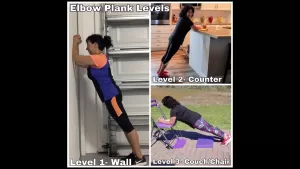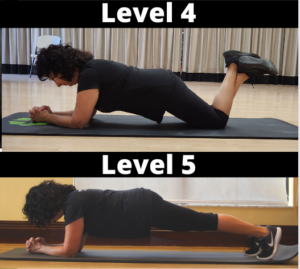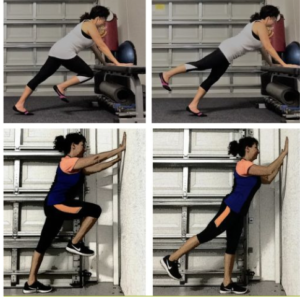Planks are a body weight isolation exercise that works the entire core. They are one of the best core exercises. Why? Undoubtedly, they strengthen your spine, rhomboids, lats, trapezius, core, quads, glutes, hamstrings, shoulder stabilizers, and triceps. On the other hand, they can be dangerous when done improperly or at the wrong level!

Floor Planks are Not Safe for Everyone
Floor planks can be too advanced for seniors, exercise beginners, obese and people with joint issues. Not only is there a fall risk getting up and down off the floor but also weak core and shoulder stabilizer muscles can cause improper form and injury. Clearly doing floor planks could be dangerous for the above group of people. The solution is to start with an appropriate safe level and to practice in a modified way.
How and Where Do Beginners Start?
A problem that beginners and seniors have is how to start off with the right exercises at a challenging yet safe level, reps and time. The best way to find out is to do a fitness test.
First test through the levels of progression below, start with the easiest and work up from there until you find an appropriate level.

Wall- (best for someone with rotator cuff and shoulder issues) this puts the least amount of stress on the shoulder joint, because the shoulder stabilizer muscles have to work when performing planks.
Time how long you can hold the wall plank, in good proper form (you can watch How to Perform a Beginner Plank video link below). If you can hold this for over a minute without any shoulder pain, then try the next level.
-
Kitchen counter level– This is usually a good level for a beginner. Time this level, if you exceed one minute, try the next level.
-
Chair, couch or bench level– Make sure to use something that is sturdy and that will not move when you plank. Tip-If you use a sturdy chair, put it by the back of a wall so it doesn’t move. If you time over a minute you can try the floor version only if it is safe to do so.
-
Modified floor(on knees) or full plank – would be the next levels of progression, but only try these if you are able to get up and down off the floor easily and do not have any joint or back issues.

If fitness testing is a challenge and you need help to determine your fitness level or don’t know what exercises are good for your body type-
Good News! I can help you, click here for my beginner 12 week online beginner workout plan that will provide exercise and nutrition accountability motivation coaching support, fitness evaluations for custom exercises for your body type and fitness level.

Video Instructions Available
PROPER ELBOW PLANK FORM:
- FORM is KEY to success!
- Set up: About 3 – 4 feet away from a wall, counter or couch.
- Feet/Legs: Hip width apart, press back through the heels.
- Hips/Back: Spine straight, hips/glutes down in a straight line with shoulders.
- Engage glutes and front of quadriceps (front of the thighs).
- Shoulder Blades: Gently squeeze shoulder blades back, down and together.
- Abdominals: ENGAGED, draw navel up towards the spine to prevent the back from arching (sticking butt up in the air) or hips sinking down too low.
- Elbows/Hands: Line up with shoulders.
- Long plank: Fingers spread apart, slight bend to elbows. If you have wrist pain, work on the elbow plank instead.
- Chest: Line up in between arms/hands, keep body elongated tall.
- Head: In line with spine, chin tucked, avoid dropping head.
- Hold the plank, breathing deeply, working through your diaphragm. Inhale through the nose, and exhale all the air out through the mouth(like blowing up a balloon).
Importantly, if you have pain in your lower back or if you do NOT feel any work in your core this means your form is incorrect. Try to realign your hips under your shoulders and pull your abdominals in tight. Above all, if pain continues STOP!
Elbow Plank Instructions
Once you determine what level is good for you, practice it 2-3 times a week, adding on 5 seconds a week. This is a great way to get stronger one step at a time. When you are able to hold it for over a minute easily, you can try to level up. The addition of upper and lower body movement variations also increases difficulty.
BEGINNER WORKOUT 12 WEEK PLAN NOW for JUST $10 a week for a 12 week complete step by step Feel Better Steps® exercise program.
Share This
